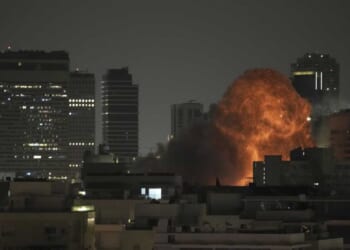
The United States military carried out a large-scale airstrike on multiple Iranian nuclear sites Saturday as part of a mission identified as Operation Midnight Hammer.
According to Pentagon officials, the strikes targeted key nuclear infrastructure, including Iran’s underground Fordow facility, as well as sites at Natanz and Isfahan.
During a briefing at the Pentagon on Sunday morning, Joint Chiefs Chairman Air Force Gen. Dan Caine confirmed that all three locations sustained “extremely severe damage and destruction.”
Trump’s Sovereign Wealth Fund: What Could It Mean For Your Money?
Caine emphasized that while the full scope of the damage is still being assessed, preliminary analysis confirms significant structural impacts at each site.
Newly released satellite imagery of the Fordow enrichment facility, located approximately 60 miles southwest of Tehran near the city of Qom, shows clear destruction to key buildings at the site.
In contrast, images taken just days before the strike revealed visible vehicle activity and logistical preparations near the underground complex.
newly released BEFORE/AFTER satellite imagery of Iran’s Fordow enrichment facility. Images 1-2: overview, June 19/20. Images 3-4: overview, June 22. 📸@maxar pic.twitter.com/hWChqsLZo8
— Mike Eckel (@Mike_Eckel) June 22, 2025
This Could Be the Most Important Video Gun Owners Watch All Year
Fordow is constructed within a mountain to shield Iran’s uranium enrichment operations from aerial assault.
Its fortified location has long made it a focal point of international concern and scrutiny over Iran’s nuclear ambitions.
The International Atomic Energy Agency (IAEA) released a statement on Sunday morning confirming that, as of that time, there had been “no increase in off-site radiation levels” following the strike.
The agency noted that it continues to monitor the situation closely.
“Following attacks on three nuclear sites in Iran – including Fordow – the IAEA can confirm that no increase in off-site radiation levels has been reported as of this time,” the agency wrote in a post on X.
Following attacks on three nuclear sites in Iran – including Fordow – the IAEA can confirm that no increase in off-site radiation levels has been reported as of this time.
IAEA will provide further assessments on situation in Iran as more information becomes available.— IAEA – International Atomic Energy Agency ⚛️ (@iaeaorg) June 22, 2025
IAEA Director General Rafael Mariano Grossi announced plans to convene an emergency meeting on Monday to discuss the implications of the airstrikes and ongoing developments in Iran.
General Caine described Operation Midnight Hammer as the most extensive B-2 stealth bomber deployment in U.S. history.
The mission utilized over 125 aircraft in total, including seven B-2 bombers, a combination of fourth and fifth-generation fighter jets, dozens of aerial refueling tankers, a guided missile submarine, and a full suite of intelligence, surveillance, and reconnaissance (ISR) platforms.
“The operation employed advanced deception tactics to ensure the successful penetration of Iranian airspace and coordination of multiple precision strikes,” Caine said.
According to Caine, the strike involved the deployment of approximately 75 precision-guided munitions.
Among these were 14 GBU-57 Massive Ordnance Penetrators, each weighing 30,000 pounds.
The mission marked the first time these weapons were used operationally.
The attack comes amid heightened tensions in the region, though no official response from Iranian state media or government spokespeople had been issued as of Sunday evening.
As international observers await further details and reactions, the Pentagon has indicated that additional assessments of battle damage and potential secondary effects will continue in the coming days.
The operation underscores the U.S. military’s capability to launch rapid, coordinated strikes deep into hardened targets and signals a significant escalation in efforts to deter Iran’s nuclear development activities.
Connect with Vetted Off-Duty Cops to Instantly Fulfill Your Security Needs

![Former Bravo Star Charged After Violent Assault Using a Rock-Filled Sock in Tennessee Walmart [WATCH]](https://www.right2024.com/wp-content/uploads/2025/07/Former-Bravo-Star-Charged-After-Violent-Assault-Using-a-Rock-Filled-350x250.jpg)



![Karoline Leavitt Levels CNN's Kaitlan Collins and Other Legacy Media Reporters [WATCH]](https://www.right2024.com/wp-content/uploads/2025/07/Karoline-Leavitt-Levels-CNNs-Kaitlan-Collins-and-Other-Legacy-Media-350x250.jpg)
![Man Arrested After Screaming at Senators During Big Beautiful Bill Debate [WATCH]](https://www.right2024.com/wp-content/uploads/2025/06/Man-Arrested-After-Screaming-at-Senators-During-Big-Beautiful-Bill-350x250.jpg)









